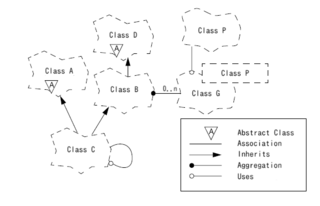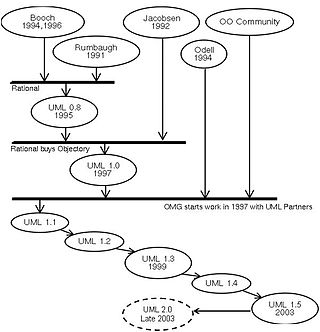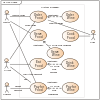
The Booch method is a method for object-oriented software development. It is composed of an object modeling language, an iterative object-oriented development process, and a set of recommended practices.

An object-modeling language is a standardized set of symbols used to model a software system using an object-oriented framework. The symbols can be either informal or formal ranging from predefined graphical templates to formal object models defined by grammars and specifications.

The unified modeling language (UML) is a general-purpose visual modeling language that is intended to provide a standard way to visualize the design of a system.

The object-modeling technique (OMT) is an object modeling approach for software modeling and designing. It was developed around 1991 by Rumbaugh, Blaha, Premerlani, Eddy and Lorensen as a method to develop object-oriented systems and to support object-oriented programming. OMT describes object model or static structure of the system.
The rational unified process (RUP) is an iterative software development process framework created by the Rational Software Corporation, a division of IBM since 2003. RUP is not a single concrete prescriptive process, but rather an adaptable process framework, intended to be tailored by the development organizations and software project teams that will select the elements of the process that are appropriate for their needs. RUP is a specific implementation of the Unified Process.
In software and systems engineering, the phrase use case is a polyseme with two senses:
- A usage scenario for a piece of software; often used in the plural to suggest situations where a piece of software may be useful.
- A potential scenario in which a system receives an external request and responds to it.

Grady Booch is an American software engineer, best known for developing the Unified Modeling Language (UML) with Ivar Jacobson and James Rumbaugh. He is recognized internationally for his innovative work in software architecture, software engineering, and collaborative development environments.
James E. Rumbaugh is an American computer scientist and object-oriented methodologist who is best known for his work in creating the Object Modeling Technique (OMT) and the Unified Modeling Language (UML).
A stereotype is one of three types of extensibility mechanisms in the Unified Modeling Language (UML), the other two being tags and constraints. They allow designers to extend the vocabulary of UML in order to create new model elements, derived from existing ones, but that have specific properties that are suitable for a particular domain or otherwise specialized usage. The nomenclature is derived from the original meaning of stereotype, used in printing. For example, when modeling a network you might need to have symbols for representing routers and hubs. By using stereotyped nodes you can make these things appear as primitive building blocks.
The Shlaer–Mellor method, also known as object-oriented systems analysis (OOSA) or object-oriented analysis (OOA) is an object-oriented software development methodology introduced by Sally Shlaer and Stephen Mellor in 1988. The method makes the documented analysis so precise that it is possible to implement the analysis model directly by translation to the target architecture, rather than by elaborating model changes through a series of more platform-specific models. In the new millennium the Shlaer–Mellor method has migrated to the UML notation, becoming Executable UML.
Object-oriented analysis and design (OOAD) is a technical approach for analyzing and designing an application, system, or business by applying object-oriented programming, as well as using visual modeling throughout the software development process to guide stakeholder communication and product quality.
UML Partners was a consortium of system integrators and vendors convened in 1996 to specify the Unified Modeling Language (UML). Initially the consortium was led by Grady Booch, Ivar Jacobson, and James Rumbaugh of Rational Software. The UML Partners' UML 1.0 specification draft was proposed to the Object Management Group (OMG) in January 1997. During the same month the UML Partners formed a Semantics Task Force, chaired by Cris Kobryn, to finalize the semantics of the specification and integrate it with other standardization efforts. The result of this work, UML 1.1, was submitted to the OMG in August 1997 and adopted by the OMG in November 1997.
Model-driven engineering (MDE) is a software development methodology that focuses on creating and exploiting domain models, which are conceptual models of all the topics related to a specific problem. Hence, it highlights and aims at abstract representations of the knowledge and activities that govern a particular application domain, rather than the computing concepts.
Objectory Systems was a software company based in Sweden that was instrumental in the development of Object-oriented program design. Founded in 1987 by Ivar Jacobson, the company developed Objectory, an object-oriented development method which was an extension of what is known as the Ericsson Approach, a modeling language developed at Ericsson. This language featured state charts with activity diagrams, as well as sequence diagrams.

The unified software development process or unified process is an iterative and incremental software development process framework. The best-known and extensively documented refinement of the unified process is the rational unified process (RUP). Other examples are OpenUP and agile unified process.
Metadata modeling is a type of metamodeling used in software engineering and systems engineering for the analysis and construction of models applicable to and useful for some predefined class of problems.

A RUP ‘hump’ is a plot of effort spent over time during a particular Rational Unified Process (RUP) discipline. The RUP hump chart consists of a collection of humps for all RUP disciplines. This diagram was created in 1993 during a workshop on architecture and process and was inspired by work by Grady Booch and Boehm. It has been part of the Rational Objectory Process after reviews by Dyrhage and Bylund and moved on to play a more important role in the RUP in 1998 when it served as the initial page for using the digital version of the process. Its final form was published by Philippe Kruchten in 1998. An older version as later used by Jacobson, Booch and Rumbaugh and an altered version was used by Royce.
Information technology architecture is the process of development of methodical information technology specifications, models and guidelines, using a variety of information technology notations, for example Unified Modeling Language (UML), within a coherent information technology architecture framework, following formal and informal information technology solution, enterprise, and infrastructure architecture processes. These processes have been developed in the past few decades in response to the requirement for a coherent, consistent approach to delivery of information technology capabilities. They have been developed by information technology product vendors and independent consultancies, such as for example the Open Group, based on real experiences in the information technology marketplace and collaboration amongst industry stakeholders. Best practice information technology architecture encourages the use of open technology standards and global technology interoperability. Information technology architecture can also be called a high-level map or plan of the information assets in an organization, including the physical design of the building that holds the hardware.
SEMAT is an initiative to reshape software engineering such that software engineering qualifies as a rigorous discipline. The initiative was launched in December 2009 by Ivar Jacobson, Bertrand Meyer, and Richard Soley with a call for action statement and a vision statement. The initiative was envisioned as a multi-year effort for bridging the gap between the developer community and the academic community and for creating a community giving value to the whole software community.
The entity-control-boundary (ECB), or entity-boundary-control (EBC), or boundary-control-entity (BCE) is an architectural pattern used in use-case driven object-oriented programming that structures the classes composing high-level object-oriented source code according to their responsibilities in the use-case realization.








